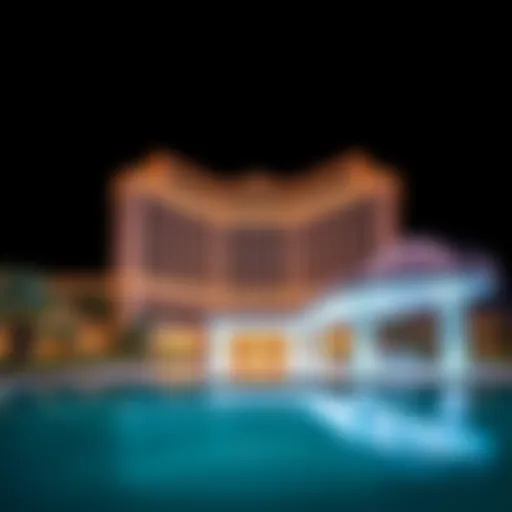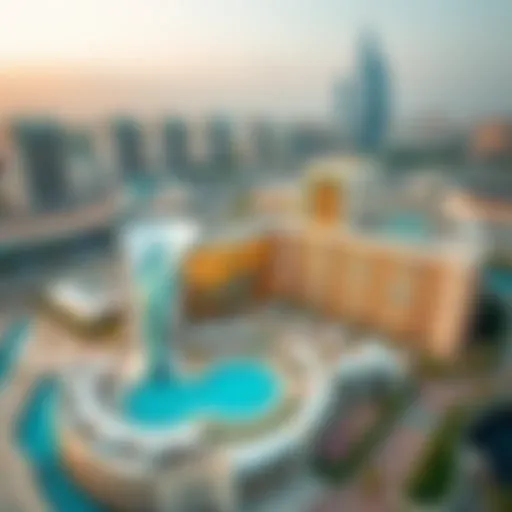Exploring the Tallest Building in the UAE


Intro
As one gazes upon the towering skyline of Dubai, it's impossible to ignore the monumental presence of the Burj Khalifa. This architectural wonder, which stands as the tallest building in the United Arab Emirates, is not merely a feat of engineering; it symbolizes the very essence of modernity and ambition. In this insightful analysis, we will dive deep into the multifaceted aspects that make the Burj Khalifa an exceptional structure and a pivotal part of Dubai's identity.
From its groundbreaking design to its socio-economic implications, the Burj Khalifa impacts not just the landscape of Dubai but also the broader context of modern architecture globally. We will unravel the historical significance of this magnificent construction, examine its engineering marvels, and delve into its effects on the real estate market, investment opportunities, and emerging trends.
As investors and enthusiasts alike look for deeper understanding, this exploration aims to provide clarity on how such grand structures come to shape not only the urban environment but also the financial and social fabric of their cities. Prepare to journey through the architectural and economic insights surrounding this marvel that reaches for the clouds.
Intro to the Tallest Building
In a world where skylines are increasingly becoming symbols of economic prowess, the tallest building in the United Arab Emirates serves as a definitive marker of both architectural ambition and national identity. This remarkable structure does more than just scrape the sky; it embodies the grit, determination, and creativity of a city that has risen from the sands of a desert to become a global hub for commerce and tourism. Understanding this edifice is imperative, not only for its magnificent stature or its aesthetic appeal but also for the intricate layers of significance it holds.
Defining Tall Structures
When discussing tall buildings, a clear definition emerges from both historical context and technical parameters. Tall buildings are typically defined as structures exceeding a certain height—often around 150 meters. But height alone does not dictate classification; aspects like design, purpose, and the engineering challenges overcome during construction must be considered as well. In places like Dubai, even a modest investment in height is met with awe, while skyscrapers are embedded into the culture like a favorite dish on a local menu.
- Skyscrapers: Generally, these buildings are over 150 meters and often have impressive architectural features.
- High-Rises: Buildings that range between 50 to 150 meters. They bring life and density to urban landscapes.
- Towers: Often more specialized in purpose, these can stand as singular pieces of art, characterizing a city’s spirit.
In essence, tall structures are not merely about physical dimensions; they symbolize the aspirations of communities and nations striving towards ever-greater heights.
The Significance of Height
Height in architecture has a plethora of significances, both practical and metaphoric. For starters, there is the undeniable prestige that accompanies towering structures. They project an image of power and innovation. As the old saying goes, "the higher you climb, the further you see"—and in this instance, height is a vantage point from which to survey not just a city but the entire world of possibilities that lie ahead.
- Cultural Impact: Iconic buildings influence art, literature, and collective memory. They become symbols of pride, often appearing in promotional materials and tourist brochures.
- Tourism Magnet: Height attracts foot traffic. People are curious about what it’s like to peer over their city from great heights, making towers irresistible tourism magnets.
- Economic Power: The financial implications are significant; tall buildings generally attract higher rents and transform surrounding neighborhoods into buzzing economic hubs.
Ultimately, height is much more than a measurement; it reflects ambitions, speaks to human ingenuity, and resonates deeply within the fabric of local identity.
"In high places, we are reminded of the possibilities that rise like the towers we build." - Anon
As we move deeper into the profile of the United Arab Emirates' tallest building, the skyscraping marvel on display invites us to explore further into architectural design, construction timelines, and beyond.
Burj Khalifa: A Profile
The Burj Khalifa stands not just as a building, but as a towering symbol of ambition and innovation, merging aesthetic allure with cutting-edge engineering. This iconic skyscraper defines the skyline of Dubai, drawing in visitors and investors alike, and serves as a testament to what modern architecture can achieve. With both functional and symbolic significance, the profile of Burj Khalifa paints a vivid picture of Dubai's aspirations.
Architectural Design
The artistic vision behind Burj Khalifa is a marvel unto itself. Designed by the renowned architectural firm Skidmore, Owings & Merrill, the structure features a triple-lobed footprint inspired by the hymenocallis flower. This design not only provides optimal structural stability but also enhances the building's aesthetic appeal, harmonizing with the natural surroundings.
The structure’s exterior is clad in reflective glazing which captures the sun's rays, creating a stunning visual effect. At night, the building lights up magnificently, turning it into a beacon of modernity against the twinkling desert sky. Every detail, from the expansive observation decks to the luxurious interiors and public spaces, was conceptualized with an unparalleled attention to detail, resulting in a piece of architecture that is equally functional and beautiful.
Construction Timeline
The construction of the Burj Khalifa was nothing short of a monumental feat. Groundbreaking occurred in January 2004, and the project was completed five years later in October 2009. Such a swift pace raised a few eyebrows, as it involved thousands of workers and significant international collaboration.
Throughout its construction, each phase presented unique challenges. Initial groundwork involved excavating a whopping 110,000 cubic meters of earth. Workers faced summer temperatures exceeding 50°C, challenging their endurance and the integrity of materials used. Nevertheless, during this five-year period, the project saw the installation of over 103,000 square meters of glass and over 100,000 liters of paint used for finishing touches. The culmination of all this effort resulted in a structure towering at 828 meters, the tallest in the world at its inception.
Height and Technical Specifications
Measuring 828 meters in height, Burj Khalifa is an architectural landmark that holds numerous records. It features 163 floors above ground, along with an additional two below. The building’s height is a significant technical achievement, showcasing advancements in materials and construction techniques.
For instance, a special concrete mix was devised that could withstand the pressures associated with such height. Moreover, the building employs a high-performance, insulated glazing system that optimizes energy efficiency. The cooling system, crucial in the hot desert climate, is another marvel; it requires nearly 10 million liters of water daily to maintain comfort levels within the structure.
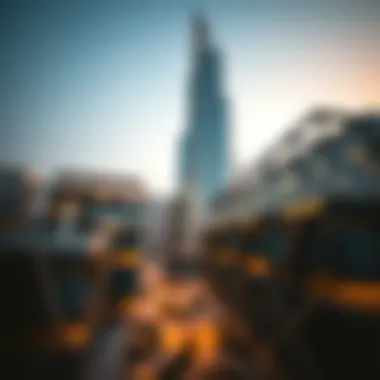

"Not only does Burj Khalifa soar into the skies, but it also reaches heights of engineering innovation and creativity that few can rival."
Overall, the Burj Khalifa functions as more than a mere skyscraper; it epitomizes the merger of art and science, symbolizing what can be accomplished with vision and determination. Its architectural design, meticulous timeline of construction, and impressive technical specifications work in unison to highlight Dubai's spirit of progression and innovation.
Engineering Feats
The engineering feats associated with the Burj Khalifa underscore its significance beyond mere height. This skyscraper is a testament to the limits of human creativity and ambition in the realms of design and engineering. When one considers the effort that went into its construction, it's far more than just a pretty face on Dubai's skyline; it represents a confluence of advanced engineering techniques and a commitment to overcoming formidable challenges.
Innovative Materials Used
The Burj Khalifa employed a range of cutting-edge materials that pushed the boundaries of traditional construction methods. Reinforced concrete is the primary structural element, carefully designed to sustain immense loads arising from the building's height. Specifically, the concrete mix used in the Burj is unique; it features a higher concentration of silica to enhance its durability.
Additionally, high-strength steel plays a crucial role in providing necessary support while maximizing space efficiency. The core of the building is formed using this type of steel, allowing it to reach unprecedented heights without compromising safety.
Some noteworthy materials include:
- Glass façade: This not only offers aesthetic appeal but also allows for natural light, reducing reliance on artificial lighting during the day.
- Thermal insulation: Essential for maintaining interior climates, this material helps mitigate the effects of Dubai's scorching heat.
These elements converge to create a structure that's not only towering but also energy-efficient.
Structural Challenges
Constructing the Burj Khalifa wasn't a walk in the park. Engineers faced a myriad of structural challenges due to its height, which brought about unique stresses and strains on the building materials. One significant issue was the shear force and torsion that come into play at such elevations. To tackle this, engineering teams used a buttressed core design, allowing the building to withstand lateral forces, particularly from wind.
Furthermore, the logistics of assembling such immense quantities of materials became an engineering project in itself. Transporting these materials to the high-rise site and ensuring they remained secure during construction was no small feat. The use of precision logistics and coordination among teams was crucial throughout the building's construction phases.
Wind and Earthquake Resistance
Given Dubai's climatic conditions and potential seismic activity, designing for wind and earthquake resistance was paramount. With the Burj Khalifa standing at a staggering 828 meters, the engineers had to factor wind loads that could potentially sway and destabilize the structure. Advanced computer modeling techniques were used to simulate wind behaviors at varying heights, which informed design decisions and material choices.
In addition, dampers were installed to absorb and dissipate energy from earthquakes or strong winds. By integrating these systems, the Burj Khalifa showcases an ability to withstand natural forces while maintaining structural integrity.
"A building is only as strong as its weakest link. The Burj Khalifa dismisses this notion through exceptional engineering prowess."
Thus, the engineering feats that form the backbone of Burj Khalifa not only place it on the architectural map but also lay down standards for future high-rises around the globe.
Economic Impact
The economic implications of the tallest building in the United Arab Emirates reach far and wide. It is not solely about the height or the architectural brilliance; it reflects the dynamic, ever-changing economic landscape of Dubai. This section will explore how this towering symbol contributes to real estate values, tourism, and job creation, painting a holistic picture of its influence on the local and national economy. Understanding these facets underlines why such high-rise structures are not mere bricks and mortar but pivotal players in economic vitality.
Influence on Real Estate Values
The Burj Khalifa has made a significant splash in the real estate sector. I mean, when you think about it, a property located close to such a colossal icon naturally spikes in value. Owning real estate in the vicinity of this marvel means more than just prime location; it’s a badge of honor.
- High Demand: Properties near the Burj Khalifa have seen consistent demand, with consumers eager to invest due to the iconic status of the building.
- Increased Rental Prices: With its recognizable silhouette gracing the skyline, rental prices for apartments and offices in surrounding areas have surged, creating lucrative opportunities for landlords.
- Commercial Opportunities: Businesses want to be associated with the Burj Khalifa’s prestige, driving up commercial real estate demand, particularly for upscale retail and dining experiences targeting affluent clientele.
This correlation between the Burj Khalifa’s prominence and the real estate market illustrates how such structures can act as catalysts for heightened economic activities in neighboring areas.
Tourism Attraction
Tourism is like the lifeblood of Dubai’s economy, and the Burj Khalifa stands tall as one of its main attractions. Visitors flock from all corners of the globe, eager for a slice of the high-life experience this building offers. The statistics speak volumes:
- Record Visitors: Millions annually make it their mission to visit, often ranking it as the top attraction in Dubai, leading to a steady influx of cash into the local economy.
- Cultural Experience: The observation deck isn’t just for the jaw-dropping views; it’s a cultural interface, showcasing Dubai’s architectural innovation, which in turn promotes cultural tourism.
- Integrated Attractions: The tower acts as a hub, surrounded by shopping venues and dining experiences. The interconnectedness of these attractions enhances the overall tourism lure.
As tourists dip into their pockets for experiences, they unknowingly contribute massively to the economy. Each ticket sold, each meal purchased, adds a ripple in the economic waters, showcasing how one building can elevate entire sectors.
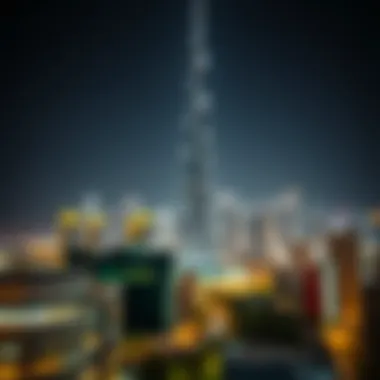

Job Creation and Economic Growth
Now, let’s look at job creation. The construction and ongoing operation of the Burj Khalifa has generated thousands of jobs, directly and indirectly. A feat of this magnitude requires a robust workforce:
- Construction Boom: The initial phase created thousands of jobs ranging from architects to laborers, igniting a construction boom that impacted various sectors.
- Service Sector Jobs: Once operational, maintaining and running the building involved hiring staff across different functions – from security to hospitality, thereby continuing to boost employment.
- Long-Term Opportunities: The styles and technologies introduced during the Burj Khalifa's construction have spurred new job opportunities in those specialized fields, encouraging workforce growth.
In essence, the Burj Khalifa is a significant player in job creation, mirroring the broader trends in Dubai’s economic growth. It serves as a beacon of progress, drawing in investment and creating employment opportunities that reverberate through the fabric of the emirate’s economy.
"The economic impact of the Burj Khalifa extends far beyond its walls. It shapes the prosperity of Dubai, influencing real estate markets, tourism, and job creation, weaving a story of progress and opportunity."
This towering structure is more than just a feat of engineering; it’s a vital artery in Dubai’s economic ecosystem.
Cultural and Symbolic Significance
The Burj Khalifa stands not just as a tall structure but as a symbol steeped in cultural significance for Dubai and the United Arab Emirates as a whole. Understanding its role goes beyond appreciating the architectural marvel; it invites us to explore narratives of growth, ambition, and identity. This aspect of the building shapes how it resonates within the region and in the global arena.
Icon of Modern Dubai
The Burj Khalifa is emblematic of modernity in Dubai. When it first opened its doors in 2010, it was like a giant beacon shining over the city, marking its transformation from a small trading town into a thriving metropolis. The structure itself has become integrated into the urban landscape, acting as a visual anchor that represents the aspirations of a city that has risen out of the desert.
Visitors and locals alike frequently link their experiences with the Burj Khalifa to their sense of belonging in a rapidly advancing society. It embodies the pioneering spirit of the Emirati people, especially as they navigate the complexities of globalization while maintaining their rich cultural heritage.
Furthermore, architecture enthusiasts from around the world flock to Dubai to see this feat of engineering. It serves not only as a tourist attraction but also as a point of pride, showcasing the UAE's capacity to achieve greatness on the global stage. The Burj Khalifa stands tall, acting as a symbol of success and opportunity, inspiring dreamers and practitioners alike, from architects to investors.
Representation of Growth
In terms of economic and social growth, the Burj Khalifa represents more than just the tallest building; it signifies the relentless drive of Dubai and the UAE to redefine their narrative. The structure reflects the tenacity of a nation that has made remarkable strides in just a few decades. It is a testament to the ambition that shapes Dubai's skyline, portraying a vision of prosperity and innovation.
The completion of the Burj Khalifa sparked a multitude of developments around it, acting as a catalyst for the surrounding areas. This follows the trend of high-rise buildings influencing real estate dynamics, where increased tourism leads to new investments in hospitality, commerce, and residential properties. Hence, we see a ripple effect; neighborhoods flourish as a direct consequence of that towering structure.
From cultural festivals to annual fireworks displays, the Burj Khalifa plays host to numerous events that draw not just residents but countless visitors, fostering trade, community engagement, and international relations. It stands as a narrative device, weaving stories of growth into the fabric of its architecture, representing ongoing change.
As the skyline of Dubai continues to evolve, the Burj Khalifa remains a touchstone for what is possible when ambition meets vision.
Sustainability Practices
In recent years, sustainability has become a buzzword in architecture and construction. For a towering structure like Burj Khalifa, integrating sustainability practices is not just a trend; it's a necessity. As the tallest building in the United Arab Emirates, the Burj Khalifa has set a standard, showcasing that modern architecture can align with environmental considerations. These practices not only bolster the building's eco-friendliness but also enhance its operational efficiency and appeal to an increasingly conscious audience.
Energy Efficiency Measures
Energy efficiency measures are pivotal in reducing the carbon footprint of high-rise buildings. At Burj Khalifa, architects and engineers employed a series of innovative techniques to minimize energy consumption. For instance:
- Double-Glazed Glass: The exterior uses a specialized low-emissivity glazing that minimizes solar heat gain while maximizing natural light, consequently lowering the demand for artificial lighting and cooling.
- Smart Building Systems: Integrated technology regulates heating, ventilation, and air conditioning, allowing Burj Khalifa to respond to real-time occupancy and weather conditions, thus optimizing energy use.
- Renewable Energy Sources: The building is partially powered by renewable energy, utilizing solar panels installed on its roof. These panels harness sunlight, contributing to the building's energy needs and promoting sustainable practices.
These measures not only trim down energy bills but also resonate with efforts to mitigate climate change. According to sources like Green Building Council, efficiency in building design can lead to significant reductions in energy wastage, which is essential for cities facing rapid urbanization and energy demands.
Water Conservation Efforts
Water conservation is another critical aspect of sustainability that Burj Khalifa prioritizes. Given the arid environment of Dubai, conserving water is not just an option but a vital initiative. Here are some of the noteworthy water conservation efforts:
- Advanced Irrigation Systems: The landscape surrounding the tower utilizes drip irrigation and moisture sensors. This technology ensures that water is used efficiently, eliminating excess consumption.
- Water Recycling: The building employs a greywater recycling system, treating wastewater for reuse in irrigation and toilet flushing. This efficient use of water helps maintain the lush greenery around Burj Khalifa without putting undue strain on local water resources.
- Rainwater Harvesting: Although rain is scarce in Dubai, any collected rainwater is captured and stored for future use, contributing to the overall water conservation strategy.
The effective implementation of these measures highlights how Burj Khalifa leads by example in sustainable construction practices. By prioritizing both energy and water conservation, it serves as a model for future high-rise projects, especially in regions where resource management is crucial.
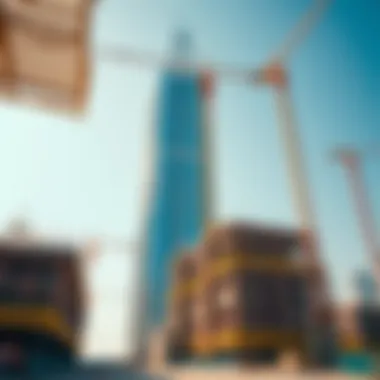
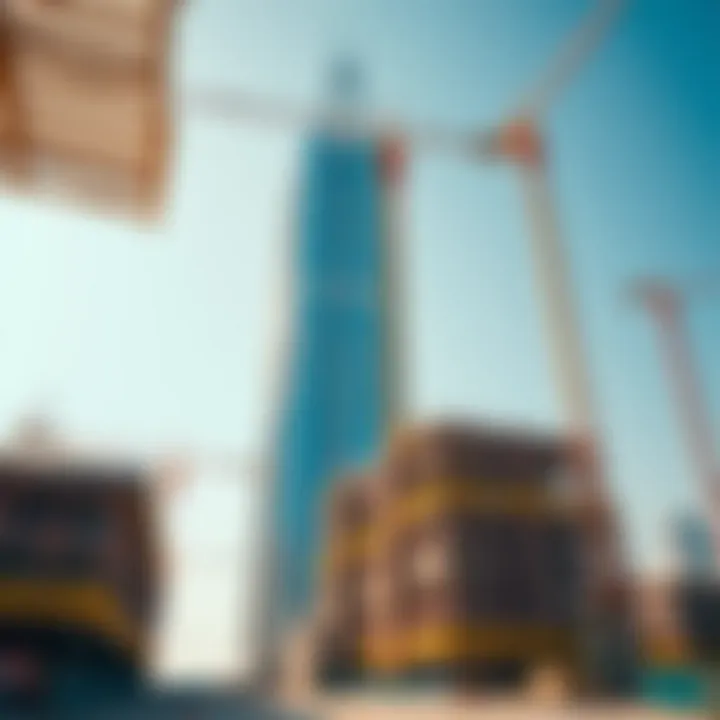
"Creating a structure like Burj Khalifa reminds us that while we reach for the skies, we must tend to the ground beneath us."
Future of High-Rise Construction
The evolution of high-rise construction is a critical topic in understanding the architectural landscape as well as the socio-economic fabric of modern cities. With urban areas expanding rapidly, the need for space becomes a pressing issue. High-rise buildings, like the Burj Khalifa, have become a prominent solution to this dilemma. This section delves into emerging trends and advancements that are shaping the future of tall structures, paving the way for more innovative designs and sustainable practices.
Emerging Trends in Architecture
Architecture is akin to a living organism, continuously adapting to the environment and societal demands. One major trend dominating discussions is the growing emphasis on multi-functional skyscrapers. These buildings don't just house office spaces or residential units anymore; they blend different uses catering to diverse needs. Imagine a tower with retail spaces, recreational areas, and residential apartments, all under one roof. This approach fosters community interaction and maximizes the utility of limited urban land.
Another noteworthy trend is the incorporation of biophilic design principles. This concept involves integrating nature into urban architecture, providing a healthier living and working environment. Living walls, rooftop gardens, and ample green spaces are becoming staples in the designs of new towers. Aside from enhancing aesthetic appeal, these features contribute positively to residents' well-being, lessening the urban heat island effect and improving air quality.
Moreover, high-rise structures are increasingly adopting smart building technologies. Sensors and automation systems enhance energy efficiency and operational performance. With data-driven insights, building management can optimize heating, cooling, and lighting based on actual usage patterns, significantly reducing energy waste.
Advancements in Technology
Technology is the backbone of modern construction, and the high-rise sector is experiencing groundbreaking innovations. One significant advancement lies in construction materials. Traditional concrete is being replaced or enhanced with materials like ultra-high performance concrete (UHPC) and carbon fiber composites. Such materials not only reduce weight but also improve the structural integrity of buildings, allowing for even greater heights.
Another area making strides is the use of drones and 3D printing. Drones offer aerial surveillance to monitor progress and ensure compliance with design specifications, while 3D printing enables the prefabrication of components off-site. This method saves time, reduces costs, and minimizes material waste.
Furthermore, augmented reality (AR) and virtual reality (VR) are transforming the way architects and builders visualize projects. AR tools allow professionals to superimpose digital information onto real-world environments, aiding in design evaluations and client presentations. VR, on the other hand, helps stakeholders experience a building even before its actual construction, enhancing communication and collaboration among teams.
"Building the future is not just about height; it’s about creating harmonious spaces that nurture communities," notes a leading architect in the field.
Visiting Burj Khalifa
Visiting Burj Khalifa is more than just standing in the shadow of the tallest building in the United Arab Emirates; it's an experience that intertwines breathtaking views with a deep appreciation for modern architecture. The Burj Khalifa, standing at a staggering height of 828 meters, is not simply a structure; it's a testament to human ingenuity and ambition. For buyers, investors, agents, and analysts pondering the allure of this iconic building, understanding the visitor experience and the access facilities provided can enhance their knowledge and potential engagement with this remarkable edifice.
Visitor Experience
The visitor experience at Burj Khalifa is curated to provide both an emotional and visual journey. Upon arrival, guests are greeted with a blend of modern design and plush hospitality. They ascend to the observation decks located on the 124th and 148th floors via high-speed elevators, which whisk visitors up to breathtaking heights in just seconds.
Once at the top, the views are simply captivating. On a clear day, the panorama extends vast miles across the Dubai landscape, offering a breathtaking glimpse of the Arabian Gulf, the sprawling expanse of the city, and even the distant desert. This vibrant scenery is not just a feast for the eyes; it's a vivid narrative of Dubai's evolution from a modest fishing village to a bustling metropolis. Visitors often feel a surge of pride and wonder, reflecting on how far this city has come.
Additionally, interactive displays about the building’s construction and its cultural significance are strategically dotted throughout the viewing areas. Guests can also enjoy the sunset vistas, where the skyline morphs in hues of orange and pink as day transitions into night. Each moment spent here etches a memorable imprint, leaving visitors with a sense of awe about what mankind can achieve.
Access and Facilities
Ease of access is crucial when it comes to enhancing the overall experience at Burj Khalifa. Located in the heart of downtown Dubai, accessing the tower is straightforward. Visitors can utilize public transportation options like the Dubai Metro, with the Burj Khalifa station just a short walk away. For those preferring to drive, ample parking spaces are available nearby.
Facilities within Burj Khalifa cater to various needs, ensuring comfort during visits:
- Restroom Accessibility: Clean and well-maintained restrooms are available throughout the building.
- Cafés and Lounges: Guests can unwind at the lounges with a refreshing beverage while enjoying the view. The atmosphere is conducive to relaxation after a long day of sightseeing.
- Souvenir Shops: Visitors have the opportunity to take a piece of the experience home with them. Shops offer memorabilia, from miniature replicas of the Burj Khalifa to local handicrafts.
- Guided Tours: For those who want to dig deeper, several guided tour options offer insights that enhance the experience, peeling back the layers of history and architectural brilliance.
In sum, Visiting Burj Khalifa presents an extraordinary opportunity to not only witness a marvel of engineering but also to engage with a multifaceted experience that enriches one's understanding of urban development and cultural progress in the UAE.
Closure
The towering presence of the Burj Khalifa extends well beyond the definition of a building. It symbolizes ambition, innovation, and resilience in the face of challenges. As a landmark, it invites reflection on its multifaceted impact, not just in concrete form but in the way it shapes aspirations and the future of urban landscapes. In this article, we’ve traversed various aspects of its existence, highlighting its architectural sophistication, engineering breakthroughs, and cultural relevance.
Summary of Key Points
- Architectural Prowess: Crafted by the renowned architect Adrian Smith, the Burj Khalifa stands as a testament to cutting-edge design and engineering. Its unique Y-shape contributes to both stability and aesthetic appeal, while its sleek exterior aims to mimic the regional desert flower.
- Economic Influence: The structure has not only reshaped Dubai’s skyline but also its economy. By attracting millions of tourists annually, it has significantly boosted the hospitality sector, further enhancing the desirability of surrounding real estate.
- Challenges Overcome: Constructing the tallest building in the world came with its share of difficulties. From the harsh desert climate to unique structural demands, the project required innovative solutions that led to advancements in construction technology.
- Sustainability Initiatives: As we face escalating environmental issues, the Burj Khalifa embraces sustainability. Incorporating advanced energy-saving features demonstrates a commitment to reducing carbon footprint and conservation of resources.
- Cultural Significance: The Burj Khalifa serves as an emblem of the new Dubai, illustrating its rise from a modest trading port to a global metropolis. It enhances Dubai's identity and asserts its presence on the world stage through grand celebrations and events.
The Role of Burj Khalifa in Future Developments
Looking ahead, the Burj Khalifa is positioned as a pivotal player in shaping both Dubai’s future and high-rise construction worldwide. As urban areas expand, the demand for vertical solutions to maximize limited space will only increase. The Burj Khalifa, with its innovative design and pioneering technology, sets a benchmark for future skyscrapers.
Developers and architects might draw inspiration from its blueprint in areas such as:
- Smart Building Technologies: Integrating state-of-the-art tech for enhanced performance and operational efficiency.
- Sustainable Building Practices: Further exploration into eco-friendly materials and energy systems, as the need for greener solutions becomes increasingly urgent.
- Mixed-Use Complex Development: Expanding the concept of multi-function buildings, where residential, commercial, and recreational spaces merge seamlessly.

